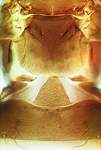
adelaidae holotype male

adelaidae female

annulosus

myopori male

myopori female

annulosus metanotum & pelta

annulosus prosternites

annulosus

annulosus antenna

adelaidae antenna
Generic diagnosis
Dark brown, macropterous, gall-inducing Phlaeothripinae. Head longer than wide; cheeks with one pair of stout setae in basal third; maxillary stylets retracted at least to postocular setae, although postocular setae no larger than minor setae. Antennae 8-segmented, III with one sense cone, IV with three sense cones, VIII broad at base. Pronotum with three pairs of capitate major setae, anteromarginals and midlaterals usually no larger than discals. Prosternal basantra not developed; mesopresternum reduced to two small lateral triangles; metathoracic sternopleural sutures elongate. Metanotum reticulate, with one pair of setae medially. Fore tarsus without tooth or with inner apex slightly recurved forming a small tooth. Fore wing parallel sided, with 6 to 9 duplicated cilia; with one or two capitate sub-basal setae. Pelta triangular, reticulate, with paired campaniform sensilla; tergites II–VII with two pairs of sigmoid wing-retaining setae; tergite IX setae S1 and S2 shorter than tube, bluntly pointed to weakly capitate, S3 acute; anal setae long. Males varying in size; large males with fore tarsal tooth massive and femora swollen, and fore coxae bearing stout setae; tergite IX setae S2 capitate but shorter than S1; sternite VIII without pore plate.
Nomenclatural data
Klambothrips Mound & Morris, 2007: 39. Type species Klambothrips myopori Mound & Morris, 2007 by original designation.
There are 5 species recognised in this genus.
Australian species
Klambothrips adelaideae Cameron & Mound, 2014: 39
Klambothrips annulosus (Priesner, 1928: 654)
Klambothrips myopori Mound & Morris, 2007: 40
Klambothrips oleariae Mound & Morris, 2007: 43
Klambothrips walsinghami (Girault, 1928: 2)
Relationship data
Although rather similar in structure to some Teuchothrips species within the Liothrips-lineage of Phlaeothripinae, preliminary molecular data suggested a more distant relationship (Mound & Morris 2007).
Distribution data
All five species are from eastern Australia with two from Tasmania. However, K. annulosus is also known from New Zealand, and K. myopori has become established as a pest in Hawaii and in California.
Biological data
Leaf-feeding, and inducing irregular leaf galls or even serious distortions to newly emerging leaves at stem apices. In Hawaii, K. myopori is considered a major problem attacking the valued native plant species, Myoporum sandwicense, and in California this thrips causes serious damage to the leaves and stems of Myoporum laetum, a New Zealand plant that is widely planted.
References
Cameron SL & Mound LA (2014) Trans-Bass Strait speciation and trans-Pacific dispersal in the Myoporum thrips (Thysanoptera, Phlaeothripinae). Austral Entomology 53: 36–41.
Mound LA & Morris DC (2007) A new thrips pest of Myoporum cultivars in California, in a new genus of leaf-galling Australian Phlaeothripidae (Thysanoptera). Zootaxa 1495: 35–45.